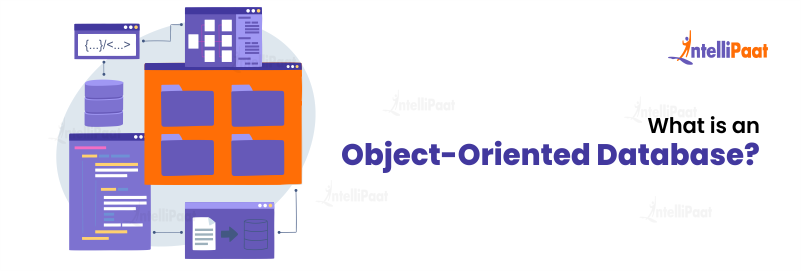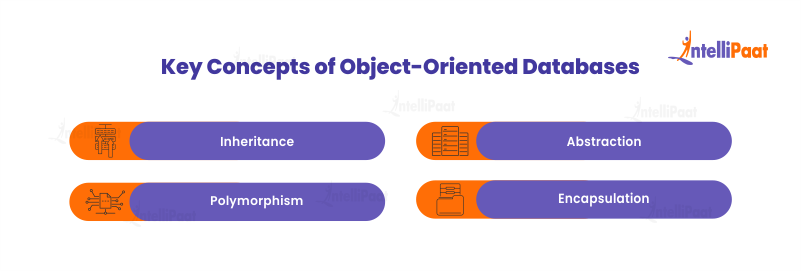Object-Oriented Database
Object-oriented databases provide a robust framework for storing and manipulating complex data structures, mimicking the real-world objects and relationships they represent. By adopting an object-oriented approach, OODBs offer seamless integration between programming languages and data storage, eliminating the need for cumbersome mapping layers. This allows developers to work with persistent objects directly, enhancing productivity and code maintainability.
So, join us as we discover OODBs and how they can revolutionize your approach to persistent object management.
- What is an Object-Oriented Database?
- Key Concepts of Object-Oriented Databases
- Advantages of OODBs
- Object-Oriented Database Vs. Relational Database
- Conclusion
Check out this SQL full course video to learn the SQL concepts:
{
“@context”: “https://schema.org”,
“@type”: “VideoObject”,
“name”: “SQL Full Course | SQL Tutorial For Beginners | Learn SQL | Intellipaat”,
“description”: “Object-Oriented Database”,
“thumbnailUrl”: “https://img.youtube.com/vi/b9FnonYxahU/hqdefault.jpg”,
“uploadDate”: “2023-07-14T08:00:00+08:00”,
“publisher”: {
“@type”: “Organization”,
“name”: “Intellipaat Software Solutions Pvt Ltd”,
“logo”: {
“@type”: “ImageObject”,
“url”: “https://intellipaat.com/blog/wp-content/themes/intellipaat-blog-new/images/logo.png”,
“width”: 124,
“height”: 43
}
},
“embedUrl”: “https://www.youtube.com/embed/b9FnonYxahU”
}
What is an Object-Oriented Database?

An object-oriented database (OODB) is a type of database management system that aligns with the principles of object-oriented programming. In an OODB, data is organized and stored in objects, which act as containers for the data and the methods that operate on that data. This design approach allows for a more natural representation of real-world entities, as objects can model complex relationships and behaviors.
OODBs are particularly suitable for applications that require dynamic data structures and intricate relationships, as they seamlessly integrate object-oriented concepts into the database realm, promoting efficient data management and retrieval.
Also, check out the SQL tutorial to learn more about databases.
Key Concepts of Object-Oriented Databases

The key concepts of OODB revolve around the principles of object-oriented programming and how they are applied in the context of database management. Here are the main concepts:
- Inheritance
Inheritance is a mechanism in object-oriented programming that allows objects to inherit properties and methods from parent objects or classes. It promotes code reuse and the creation of hierarchical relationships between objects.In the context of OODBs, inheritance enables the organization and structuring of objects into a class hierarchy. It facilitates the sharing of common attributes and behaviors between objects, simplifying the modeling and manipulation of data.
- Abstraction
Abstraction is a concept that focuses on representing complex systems or entities by emphasizing their essential characteristics while hiding unnecessary details. It allows us to create abstract models or classes that capture a group of objects’ common attributes and behaviors.
In object-oriented databases, abstraction enables the definition of high-level objects that abstract away implementation complexities, making it easier to understand and work with the data. - Polymorphism
Polymorphism is the ability of objects to take on multiple forms or exhibit different behaviors based on their context. It allows objects of different classes to be treated as objects of a common superclass, promoting flexibility and extensibility in object-oriented systems.Polymorphism in OODBs enables objects to respond differently to the same message or method call, depending on their specific class or inheritance hierarchy. It simplifies the management of objects with varying behaviors and promotes code reuse and flexibility in modeling complex relationships between objects.
- Encapsulation
Encapsulation refers to the concept of consolidating both data and the corresponding methods that manipulate that data into a cohesive entity, commonly referred to as an object. It provides data protection and information hiding, ensuring that an object’s internal state is accessible and adaptable only through defined interfaces.Encapsulation in OODBs ensures that data integrity is maintained by controlling access to the object’s data and enforcing the use of specified methods for data manipulation.
Check out our SQL Course to have a complete grip on SQL concepts.
Advantages of OODBs
Object-oriented databases (OODBs) offer several advantages over traditional relational databases. Here are the key benefits of OODBs:
- Natural Modeling: OODBs allow for more natural and intuitive modeling of real-world entities. The object-oriented approach aligns well with how we think about and interact with objects in the real world. Objects in an OODB can directly represent entities, their attributes, and their relationships, making it easier to understand and work with the data.
- Complex Data Structures: OODBs excel at handling complex data structures. Objects can be interconnected through relationships, enabling the representation of intricate data models. This makes OODBs well-suited for applications that deal with complex and evolving data structures, such as computer-aided design, multimedia systems, and scientific applications.
- Code Reusability: OODBs support inheritance, allowing objects to inherit properties and methods from parent objects or classes. This promotes code reuse and reduces redundancy, as common functionalities can be defined in a superclass and inherited by subclasses. Code reusability enhances development productivity and simplifies maintenance.
- Flexible Querying: OODBs often provide object-oriented query languages based on object-oriented constructs for querying data. These query languages enable expressive and flexible querying, allowing developers to navigate complex object relationships and perform complex searches efficiently.
- Persistence: OODBs ensure data persistence, meaning that objects and their associated data persist beyond the lifespan of a program. This eliminates the need for separate data mapping layers and simplifies the storage and retrieval of object data.
- Performance: OODBs can offer better performance for specific applications compared to relational databases. Directly mapping objects to the underlying storage can reduce the need for complex joins and data transformations, resulting in faster data access and retrieval.
Intellipaat provides Database Courses for its learners by industrial experts. Enroll now and get ready to learn more.
Object-Oriented Database Vs. Relational Database

Object-oriented databases (OODBs) and relational databases (RDBs) are different approaches to storing and managing data. Here’s a tabular comparison between the two:
| Criteria | Object-Oriented Database (OODBs) | Relational Database (RDB) |
| Data Representation | OODBs represent data as objects, which encapsulate data and methods. Objects can directly model real-world entities and their relationships. | RDBs represent data using tables with rows and columns. Every row within the dataset represents a distinct record, while each column corresponds to a specific attribute. Primary and foreign keys are used to create relationships. |
| Data Modeling | It supports complex data structures and relationships, allowing for flexible and intuitive modeling. Inheritance facilitates code reuse and hierarchy representation. | RDBs represent data using tables with rows and columns. Every row within the dataset represents a distinct record, while each column corresponds to a specific attribute. Primary and foreign keys are used to create relationships. |
| Querying | OODBs often provide object-oriented query languages (e.g., OQL), enabling expressive and flexible querying using object-oriented constructs. Navigating object relationships is straightforward. | It uses structured query languages (e.g., SQL) for querying. SQL focuses on relational algebra and set-based operations, making it well-suited for complex joins and aggregations. |
| Scalability | It can handle complex and evolving data structures efficiently. However, scalability can be challenging when dealing with large-scale deployments and high transaction volumes. | RDBs have proven scalability in handling large datasets and high transaction rates. The well-established relational model allows for optimized query processing. |
| Development and Maintenance | It promotes code reusability through inheritance and provides a more natural modeling approach. However, designing and maintaining the object schema can be more complex and require careful consideration. | It provides a structured and well-defined data model, making schema design and maintenance relatively straightforward. SQL-based tools and expertise are widely available. |
Check out the list of SQL Interview Questions.
Conclusion
In conclusion, object-oriented databases offer numerous advantages over traditional relational databases. It makes them a viable option for specific use cases. From the seamless representation of complex data structures to efficient querying and retrieval, they naturally express complex data structures. They support inheritance and encapsulation.
Object-oriented databases may not be the best fit all the time. Still, they offer unique benefits and can be valuable tools for managing and manipulating complex object-oriented data structures effectively.
Still in doubt? Put your query on the Intellipaat community page!
The post Object-Oriented Database appeared first on Intellipaat Blog.
Blog: Intellipaat - Blog
Leave a Comment
You must be logged in to post a comment.







